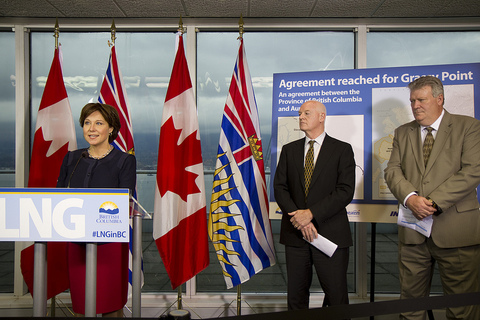B.C.’s natural gas ambitions not in keeping with climate leadership
4 min read
Climate & Clean Energy | Blogs | David Suzuki Foundation –

The B.C. government’s liquefied natural gas plans would have a major impact on the global carbon budget.
(Credit: Province of British Columbia via Flickr)
To get a sense of how far B.C. has strayed from its status as a climate leader with a meaningful understanding of the threat of climate change look no further than its recent announcement on gas reserves. In a news release, the provincial government proudly proclaimed that B.C.’s natural gas reserves are twice as large as the previous estimate. B.C. has doubled the size of its reserves to 2.9-quadrillion cubic feet. (Yes, quadrillion is a real number.) The implication is that we can start exporting liquefied natural gas (LNG) with little concern for domestic energy security. What is not said, however, is how developing even a fraction of this gas is consistent with our atmospheric, environmental and physical security based on avoiding dangerous climate change.
Put in context, if we developed this massive reserve and burned all the gas, it would emit 159-billion tonnes of CO2. There’s wide scientific consensus that the Earth’s climate system could sustain an additional 470-billion tonnes over the next century to only heat up by 2 C. There’s further scientific consensus that any warming above 2 C is very dangerous, not only for the environment but also for human civilization generally. The World Bank sounded the alarm in 2012 about warming over the next century: “A world in which warming reaches 4°C above preindustrial levels would be one of unprecedented heat waves, severe drought, and major floods in many regions, with serious impacts on human systems, ecosystems, and associated services.” Burning this massive reserve would use up 40 per cent of the world’s remaining carbon budget over the next hundred years.
If the government were a climate leader, the doubling reserve estimate would come with a warning of how most of this gas would have to stay underground and not be developed. The scale of the reserves has the potential to drastically alter our atmosphere and increase the risks of climate impact within our lifetime. Instead, the size of reserves was showcased as though it were a great achievement.
Some would argue that gas has half the carbon intensity of coal and that replacing coal with gas, as the U.S. has done over the past five years, has led to absolute greenhouse gas emission reductions. This is true, and it’s a good development in the short term. But in the longer term when B.C.’s reserves will start to matter, the size of the reserves dwarfs what would be plausible if we are to limit warming to 2 C.
The International Energy Agency developed a long-term scenario for how the world could pursue an energy system that keeps warming at 2 C. It showed that, because of its lower carbon intensity, natural gas use would go up absolutely from now to 2035 by 20 per cent. What does this mean for B.C.’s natural gas ambitions? First, the size of B.C.’s reserve is 23 times larger than peak global gas demand by 2035. (Gas use would decline out to 2100.) B.C. now supplies one per cent of the global gas production market, making it a small player. Only a fraction of the reserve could be developed to be consistent with a global energy system that avoids the worst of the warming. If B.C. thinks it has the right to exploit these reserves, how can it persuade other countries not to develop theirs? The evidence from climate science clearly shows that most of this reserve must stay in the ground.
The cognitive dissonance with this government’s natural gas romance and climate change leadership is troubling. Just look at the government’s position after the recently announced Pacific Coast Action Plan on Climate and Energy. The agreement says four jurisdictions–California, Oregon, Washington State and B.C.— will work together to achieve targets, and it notes that “British Columbia has already legislated 2020 and 2050 targets…to reflect scientific findings.” Point 3 of the agreement states unequivocally that policy must be informed by climate science. B.C. Environment Minister Mary Polak used the news release announcing the agreement to justify the government’s LNG development ambitions, claiming that B.C.’s LNG will support markets by providing the cleanest burning fossil fuel. Nowhere did she mention that, as the agreement states, the science dictates that we need to show restraint, not blind ambition, when handling this climate-altering resource.
(c) Climate & Clean Energy | Blogs | David Suzuki Foundation – Read entire story here.




